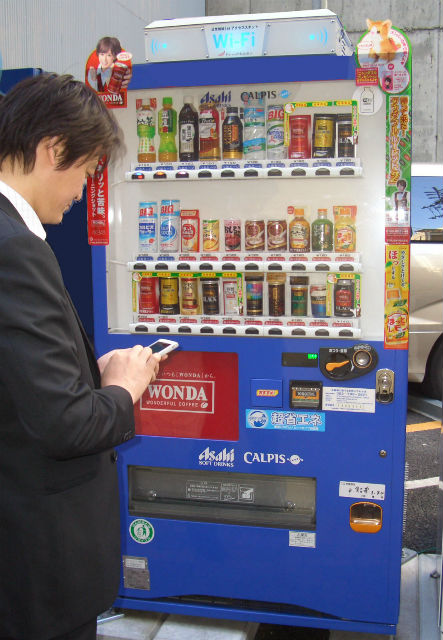The most popular ones are for soft drinks, as you can see in the video clip above. The one he chose, Pocari Sweat, is similar to Gatorade. It's a pretty strange name but most products in Japan are like that - when spelled alphabetically, the name just comes out weird. That's very common in any foreign culture, I think. And it applies in reverse too. Some names of American products brought into the Japanese market may have names that sound funny to them as well.
Soft drinks and cigarettes are very common in vending machines in Japan, but there are so many other types of products for sale in these machines too. In busy train stations in Japan you'll see people lining up at ticket vending machines, which gives me great confusion every time I go there even though I completely understand Japanese.
I saw a television program featuring cook and traveler Anthony Bourdaine buying fried chicken from a vending machine. He opened the package and said, "warm... soggy". They have coffee brewing vending machines like in the video above, cups of noodles (you can get hot water from the vending machine), and snacks. If a commodity can be sold over a counter, you can probably also buy it from a Japanese vending machine.
Most of these machines take both coins and bills, a lot of them are also equipped to handle transactions by keitai (cell phone). If you have the right kind of cell phone and contract, you can buy a drink by touching your phone to the panel. This kind of cell phone is called "osaifu keitai お財布携帯 (wallet cell phone)". Also, prepaid cards like Suica (prepaid rechargeable train card, we'll talk about it later in a train post) can be used.
Vending machines offer not only convenience - their usefulness goes beyond that. The one pictured at the left is a new kind. The kanji is 災害対策用自販機 (saigai taisaku-yo jihanki) and it means vending machine in case of an emergency. These vending machines will release the drinks for free in emergency situations like natural disasters. They came into use after the 3.11 earthquake and tsunami in 2011.
Also, most vending machines like this have a sticker stating the address. It started in 2005 for people who need to know what the exact address is for that location in case they have to call the police, fire department or an ambulance for help.
Now, here is the newest machine with a high tech feature: free WiFi! This vending machine has a built-in WiFi router.
Asahi Calpis Beverage Co., Ltd. (by the way the guy in the first video didn't know Calpis, a long time Japanese favorite yogurt-like drink) has announced they will install 1,000 WiFi vending machines in 2012, mostly in the big cities like Tokyo, Osaka, Nagoya, Fukuoka and Sendai to start, and 10,000 more in next 5 years. Such a vending machine will generate a WiFi signal within a 50-meter radius. A customer can use it for 30 minutes maximum (it cuts the connection after 30 minutes - you have to access it again after the 30-minute time period).
This is another confusing thing - why has no one yet solved the issue of how to provide free WiFi in Japan. At least such vending machines are a positive step in addressing this dilemma. So far, I have only seen news releases about these machines from the distributor - no comments from actual users yet. We'll tell you more about this when we actually hear from first hand users who experience this new convenience.

